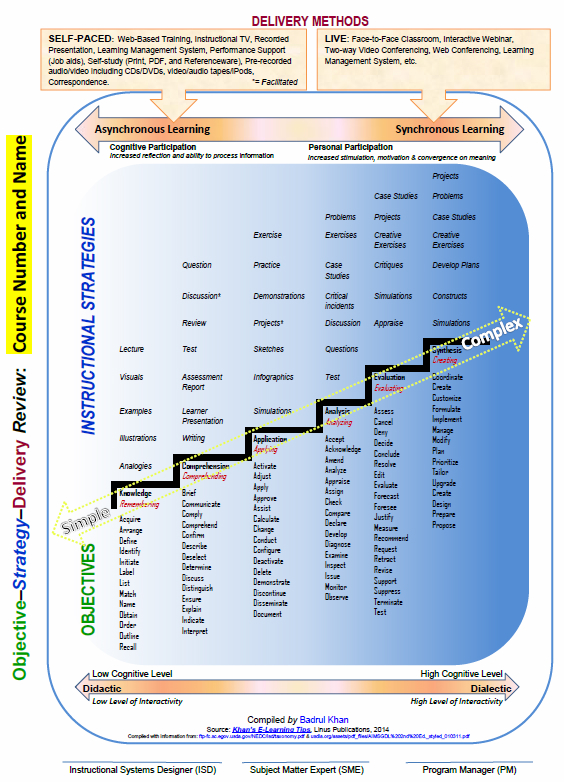———————————————————————————————————-

Q & A
- I am looking over your compilation of Blooms Taxonomy: Objectives- Instructional Strategies-Delivery Method Considerations Chart Compiled by you. I notice that you value synchronous learning (personal participation) as more complex than asynchronous learning (cognitive participation, individual reflection and process). I am stumped by why you would think the human interaction piece yields a greater more complex learning experience than one deep in reflective and concentrated efforts? Some groups are productive, and deep into learning, some groups are not. However, at a personal participation level, the cognitive participation of an earnest learner seems to me to yield much more concentrated effort that includes a depth of field not often reached in groups. Granted, the synchronous learner environment tends to be high energy, but mostly due to personal exposure in sharing a point of view subject to the evaluation of others, and this tends to be intense. But other than that intensity, experientially the group shares an experience that may or may not yield strong results, while the concentrated learner writes, conduct research, thinks, complies, plans, prepares, designs and prioritizes just the same and …perhaps better. Am I missing some importantly vital piece to this? (Submitted by a students of San Francisco State University’s ITEC 860 class)
- I think that you’re misinterpreting the rationale and intent behind the Bloom’s graphic. The Bloom’s Taxonomy simply breaks objectives into a range of objectives from the relatively simple, like knowledge/remembering on the left, to the complex, like synthesis/creating on the right. The diagram just indicates that the objectives that are simple to achieve on the left-hand side can be efficiently achieved by an individual learner with cognitive participation using asynchronous types of learning activities. However, the complex objectives on the right-hand side of the taxonomy can be best achieved by the learner through personal participation in a synchronous environment. This is not to say that an individual learner cannot meet the more complex objectives through individual study. However, in a synchronous learning environment the learners don’t just learn from the training materials. The quality of the learning experience is significantly enhanced not only by the insights shared by the instructor, but also by what they can learn from the perspectives and life experiences the other learners have about the content that they share in the synchronous learning environment. It’s not just the fact that people are participating in a group activity, but the andragogical principle that the sharing of learners’ life experiences in the context of the learning environment that significantly enhances the learning that takes place in an adult educational environment. An example of this is when a class does the “Lifeboat” exercise where first every learner individually makes up a list of the important things that they would like to have if they were going to be in a lifeboat when their ship sinks. When the learners then get together in groups and work in groups to come up with a combined list, they find that there are a number of important things that should be included that they had not thought about. The list created by the group is usually a better, more comprehensive list because it reflects the synergy and interaction of people with different backgrounds and perspectives. This is what allows the group to consider a wider variety of options, needs, and conditions; and thus allows the group to develop a more comprehensive list based on the combined knowledge and experience of the group as a whole, rather than the more limited knowledge and experience of one individual. (Answered by Chris Heizer, a reviewer of the Chart)

